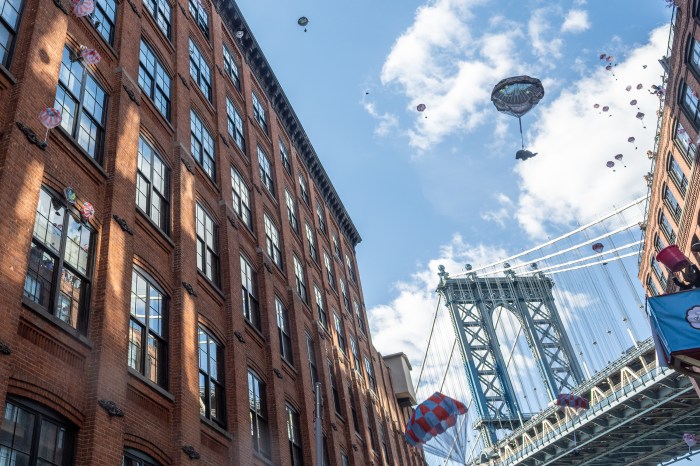They’re not on the chopping block!
The Belgian blocks lining Dumbo’s streets are staying put, despite reports claiming they are in danger of being “ripped out” in order to make the roads compliant with federal standards for the disabled, according to a Department of Transportation rep.
“I want to be very clear that the Belgian block configuration in Dumbo is not being removed,” said agency spokesman Scott Gastel. “The idea that the character is disappearing from the streets of Dumbo is not true.”
The city has been planning to smooth out the cobblestone-like blocks for years to meet national codes that mandate all streets and sidewalks be accessible to people with mobility issues. The Historic Districts Council, which advocates for landmarked neighborhoods, released a study earlier this week stating that a chunk of the historic enclave’s Belgian blocks aren’t up to federal standards, leading several media outlets to report they may have to be torn out.
But instead being scrapped, the 18th-century relics will be removed, inspected, cleaned, then smoothed to meet accessibility requirements, according to a spokesman for the Department of Design and Construction, which is overseeing the project.
Belgian blocks that can not be brought up to code will be replaced with new ones, according to the rep, who said their net total will not change.
The streets are protected under the neighborhood’s historic district designation, but can be altered upon approval by the Landmarks Preservation Commission.
The transportation department will go before the commission in September with its revised plans to spruce up swathes of the nabe — including Adams, Main, and Pearl streets from Adams to Front streets, Jay Street from John to Water streets, Water Street from Adams Street to Hudson Avenue, and Plymouth Street from Main to Jay streets — while it fixes area sewer systems.
The work includes creating concrete sidewalks on streets where there are none, installing granite-block crosswalks, and replacing old rail tracks with crane rails so wheelchairs, walkers, or strollers don’t snag on them. The unusual layout of streets and rail lines is rooted in Dumbo’s industrial past, when freight cars would go straight into warehouses, eliminating the need for sidewalks.
The Belgian blocks, which have been in place for roughly 150 years, are cherished by residents and visitors from around the world for their old-timey charm.
But they regularly cause headaches for locals who have to tread them daily, according to the head of a neighborhood commerce group.
“The Belgian blocks of Dumbo are much beloved but a little beleaguered,” said Alexandria Sica, president of the Dumbo Business Improvement District. “Businesses are asking when the streets are going to be fixed because their employees have to bike down the wrong side of the road on one block, because it’s full of holes. And mothers with strollers are constantly in my ear about how they can’t safely get across Pearl Street.”
The city did not specify what makes an old block suitable for reuse, making it difficult to gauge how many will be lost, according to a preservationist.
“How do they judge what’s unsalvageable? These things are granite, they’re still very hearty,” said Simeon Bankoff, executive director of the Historic Districts Council, which published the Belgian-block study.
The group understood that commissioning the report might lead consultants to conclude that the relics need to go, he said, and chose to proceed because it wanted to put together an educational manual for the city to consult when determining how to manage the historically paved streets. And Bankoff hopes officials devise a plan that saves as many Belgian blocks as possible, while also making the streets usable for all.
“We would like to see the greatest possible retention of the historic fabric that is there, and we accept there are areas where it’s appropriate and necessary for [the city] to create accessibility,” he said.






















